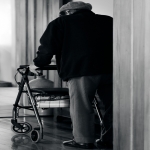How Serious is Being a Fall Risk?
 A fall may not seem like a huge issue until a bone is broken, a person is hospitalized, or a disability is acquired. Fall risk tends to increase as a person ages and may prohibit older individuals from performing daily activities pertinent to their lifestyle. Exercising, going grocery shopping, and walking their pets can all be affected because of a fall.
A fall may not seem like a huge issue until a bone is broken, a person is hospitalized, or a disability is acquired. Fall risk tends to increase as a person ages and may prohibit older individuals from performing daily activities pertinent to their lifestyle. Exercising, going grocery shopping, and walking their pets can all be affected because of a fall.
Unfortunately falls are common and according to the U.S. Department of Health & Human Services, “more than one in three people age 65 years or older falls each year.” There are many risk factors for falling that every individual should be aware of. Declining health is one of the main risks for falls. Falls tend to increase with a decrease in eyesight, hearing, and reflexes.
Other health conditions that may alter balance include:
- diabetes
- heart disease
- thyroid imbalance
- nerve damage
- muscle weakness
If you or a loved one are suffering from one of the above conditions or find that certain medications cause dizziness, sleepiness, or confusion, you might be at risk of a fall.
 Fortunately, falls can be prevented rather easily. To begin to lower fall risks, one must take care of their personal health. First, one must remain physically active. Exercise will increase muscle tone, facilitate balance, and slow bone loss in aging individuals. Additionally, one must partake in a yearly medical physical, eye exam, and hearing exam. These medical evaluations are pertinent as a person ages and assess whether their body, eyesight, or hearing are declining.
Fortunately, falls can be prevented rather easily. To begin to lower fall risks, one must take care of their personal health. First, one must remain physically active. Exercise will increase muscle tone, facilitate balance, and slow bone loss in aging individuals. Additionally, one must partake in a yearly medical physical, eye exam, and hearing exam. These medical evaluations are pertinent as a person ages and assess whether their body, eyesight, or hearing are declining.
 As always, one should contact a primary care doctor if there are any changes to his or her health. Also, one must assess their medications, behaviors, and personal belongings to ensure they are not inadvertently placing undue fall risk upon themselves. For instance, if a medication is causing dizziness or confusion, consult a doctor and discuss other alternatives. Or if one consumes alcohol on a regular basis, one should consider reducing their intake to increase their awareness of their surroundings. Finally, one must assess their belongings, such as their shoes, homes, and assistive walking devices. Shoes should fully support each foot, be low-heeled, and preferably rubber-soled. If balance is becoming an issue, living in a home with the least amount of steps possible may be advisable as well as the use of a cane or walker. Above all, consultation with a doctor is key to lowering the risk of falls.
As always, one should contact a primary care doctor if there are any changes to his or her health. Also, one must assess their medications, behaviors, and personal belongings to ensure they are not inadvertently placing undue fall risk upon themselves. For instance, if a medication is causing dizziness or confusion, consult a doctor and discuss other alternatives. Or if one consumes alcohol on a regular basis, one should consider reducing their intake to increase their awareness of their surroundings. Finally, one must assess their belongings, such as their shoes, homes, and assistive walking devices. Shoes should fully support each foot, be low-heeled, and preferably rubber-soled. If balance is becoming an issue, living in a home with the least amount of steps possible may be advisable as well as the use of a cane or walker. Above all, consultation with a doctor is key to lowering the risk of falls.

Sources:

